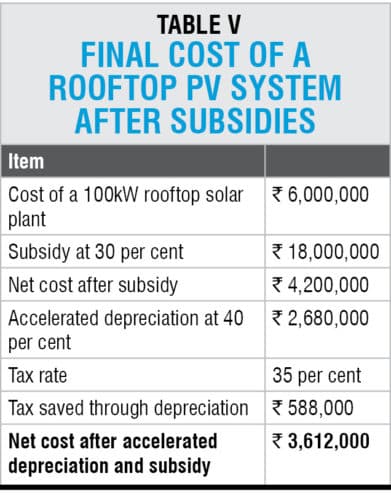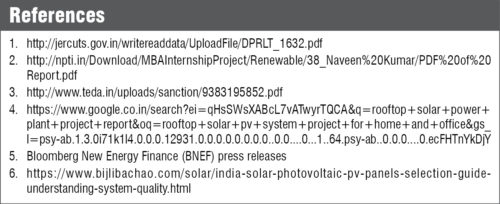A guide to starting solar rooftop installation business in India
The Indian government has set its sights on having 175GW of non-hydro renewable capacity (made up of 60GW onshore wind, 60GW utility-scale solar, 10GW bio energy, 5GW small hydro and 40GW rooftop solar) by 2022. At present, this figure stands at just 60GW.
India is accelerating development of renewable energy projects to provide cheap, reliable and clean power to its 1.3 billion people. The country’s per-capita on-grid electricity consumption increased by 22 per cent over the four years ending March 2017 due to increased industrial activity, higher uptake of electrical appliances by residential electricity users and addition of new consumers to the grid—according to a report by Bloomberg New Energy Finance (BNEF).
Majority of the capacity in the 2022 target—a total of 135GW—is utility-scale (wind farms and solar parks, in particular). The BNEF report estimates that India will need to invest $83 billion to build this capacity. The good news is that, because of falling capital costs per MW, that figure is $19 billion less than BNEF’s previous estimates.
But some of the most interesting activity will be in small-scale solar, that is, rooftop solar installation. According to BNEF, rooftop solar in India will grow inevitably with or without the support of power distribution utilities. India will need to invest $23 billion over the next five years to meet its 40GW rooftop photovoltaics target by year 2022.
The cost of electricity from solar rooftop PV has halved in the last five years due to fierce competition in the market and drop in equipment prices. In contrast, average retail electricity rates have increased by 22 per cent during the same period. This has made rooftop PV cheaper than commercial and industrial grid tariffs in all major states of India.
However, BNEF expects residential sector PV growth to pick up rapidly post-2021. At the moment, its attractiveness is being held back by the requirement of high upfront capital expenditure, shortage of financing options, and the fact that grid electricity is cheaper for residential consumers with low consumption.
BNEF experts also indicate that net metering is a far more important enabler for residential small-scale solar than business-scale projects.
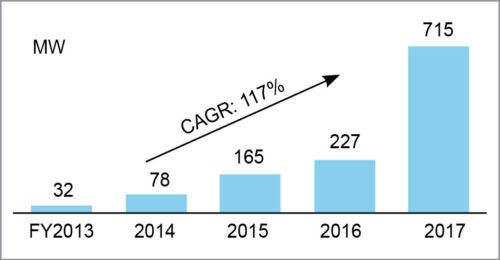
Homeowners usually draw less power during the hours when their PV panels are producing, making self-consumption much harder. Solar projects also have a big and untapped potential to power irrigation pumps and reduce the use of back-up diesel generators. Huge growth of rooftop solar presents business opportunities in rooftop solar system installation.
This project report provides a brief overview of solar rooftop PV plant installation service. Thus it acts as a guide on how to start a business in this area.
Components required
Components of a solar rooftop system are the same anywhere in the world. That said, however, some components make more sense for some regions than others.
For regions such as India and Africa that are keen to use rooftop solar as a source of backup power during grid power outages, batteries could be required at least in select cases. For developed countries such as USA and the European Union where grid outages are rare, batteries are usually not required as backup, with grid supplying the deficit power.
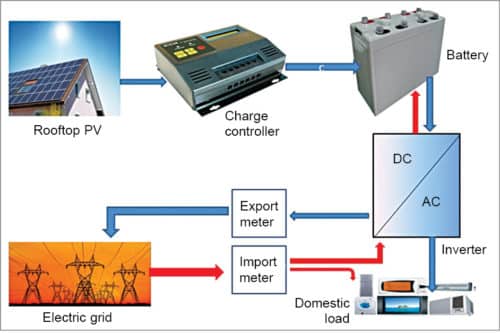
Similarly, some regions of the world require use of trackers for rooftop solar as their rooftop areas are smaller than required to meet their power needs. For some other regions, trackers might not make a good business case.
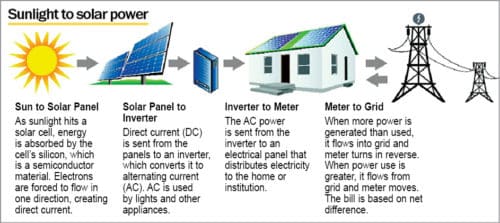
Key components of a rooftop solar plant include:
Solar photovoltaic modules (panels)
There are two kinds of modules, viz, thin-film and crystalline. Rooftop solar plants predominantly use crystalline panels because these are more efficient and therefore better suited to rooftop installations where space is a constraint. Panel efficiency and capacity rating are two important parameters of solar panels.
Inverters
Inverter determines the quality of AC power you get, and also the kind of loads that can be powered with solar. Different inverters support different levels of starting current requirements, which affects the kind of machinery that can be run on solar power. Inverters are also the only major component of the solar plant that are replaced during the lifetime of the plant.
Mounting structures
Solar panels are mounted on iron fixtures so that these can withstand wind and panel weight. The panels are mounted to face south in the northern hemisphere and north in the southern hemisphere for maximum power tracking. Panels are tilted at an angle equal to the latitude of that location.
Proper design of mounting structures is crucial for the power plant performance as the power output from the PV plant cannot be maximised if the mountings buckle and panels are not optimally oriented towards the sun. In addition, improperly mounted panels present a ragged appearance that is not pleasing to the eye. Mounting structures should also allow sufficient air circulation to cool the PV panels as rooftop PV plant output falls with temperatures rising above 25°C.
Solar trackers
Tracking is a mechanism for panel mounting that allows panels to follow the sun as it moves across the sky. Single-axis trackers follow the sun as it moves from east to west during the day, while dual-axis trackers also follow the sun on its north-south journey over the course of a year.
Trackers can increase the power output of a PV plant but add significantly to both the initial cost of the plant and maintenance expenditure. So trackers should be used on a case-to-case basis after performing a cost-benefit analysis over the lifetime of the rooftop plant.
Batteries
A battery pack can add 25-30 per cent to the initial cost of a rooftop PV solar system for one-day autonomy (storing an entire day’s output). Inverters with integrated charge controllers are preferred so that the inverter can direct grid power or solar power, based on the availability and demand, to charge batteries. This extends the battery life compared with standalone charge controllers that allow parallel charging between grid and solar power at different power levels, damaging the battery. If batteries are required, it is vital to perform a lifetime cost-benefit analysis to understand the impact on the cost of rooftop solar power.
Other miscellaneous items required include:
1. Power-conditioning unit
2. Array junction box (AJB)/DC distribution box array junction box/ DC distribution box
3. Common AC distribution box
4. Common AC distribution panel board
5. Cables; DC cables carry current from panels to inverters, while AC cables carry current from inverters to loads
6. Wire
7. Lightning protection
8. Earthing protection
9. Jet pump
Basics of rooftop solar PV
Solar PV panels (also known as solar PV modules) work by converting sunlight into electricity. These do not use the heat from the sun, and can, in fact, output reduced power in hot climates. The electricity generated by PV panels is direct current (DC), which needs to be converted into alternating current (AC) using an inverter.
Panels are mounted on the rooftop using special mounting structures. If solar power is required when sunlight is not enough for the panels to generate electricity (such as at night), battery backup is required.
Types of solar PV systems
Grid-tied systems are a combination of solar PV and grid. As these systems depend on the grid-supplied reference voltage for their operation, grid-tied systems do not work when the grid is down.
Grid-interactive systems work in conjunction with either battery backup or diesel generator to support loads even during power failure.
Off-grid systems operate independent of the grid. These systems sync with diesel generators and/or batteries. Battery-based systems were uncommon in the past due to their high costs. However, the situation is changing now, given the improved economics of battery technology.
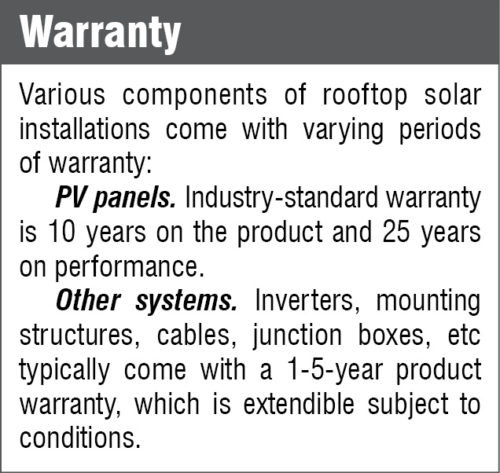
Types of mount
Mounting systems for rooftop installations are available for both inclined and flat roofs.
A variety of mounting systems are available, the most common being railed, rail-less and shared rail. All these systems require some type of penetration or anchoring onto the roof, whether attached to rafters or directly to the decking. The standard residential systems use rails attached to the roof to support rows of solar panels. Each panel, usually positioned vertically/portrait-style, attaches to two rails with clamps. The rails secure to the roof by a type of bolt or screw, with flashing installed around/over the hole for a watertight seal.
Business economics
Solar business models include:
1. Service-based operation. Types of services being solar rooftop power plant installation and maintenance
2. Operational model. Just-in-time sourcing of components and products as per the project requirement
3. Financial model. A low-cost model where investment is done for mainly fixed and variable cost heads. Raw material or tools are purchased after order confirmation by the customer, utilising the advance from the customer.
Fixed-cost items include:
1. Company registration
2. Solar installation training
3. Certification
4. Miscellaneous fixed assets (laptop, smartphone, etc as per requirement)
Variable-cost heads include:
1. Human resource
2. Marketing
3. Office space
Detailed business economics, including estimated value against the above-mentioned cost heads and other probable cost heads, along with breakeven point (BEP) calculation can be worked out based on the scale of operation desired. However, an overview of solar rooftop power plant installation cost and relevant subsidies and incentives is given below.
Solar rooftop power plant installation cost
Rooftop solar power plant installation costs roughly ₹ 55-60 per watt depending on the quality of components selected. Costs of different rooftop power plant components are listed in Table I. The table does not include battery backup as its cost depends on the extent of backup opted for. Not only do batteries add to the initial cost, recurring maintenance and replacement expenditure, the energy loss on charging and drawing from the battery also add to the electricity cost.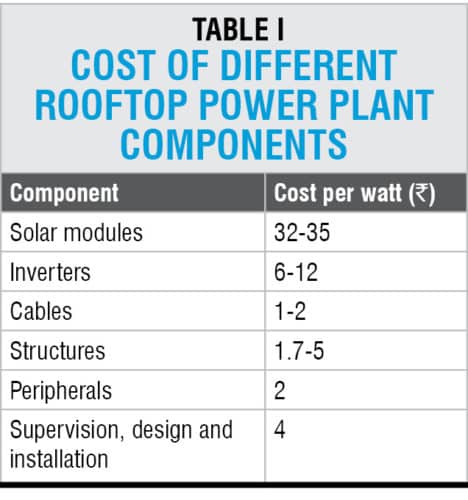
Subsidies and incentives available for rooftop solar PV plants
Several incentives are available for rooftop solar PV plants. Broadly, these can be categorised as accelerated depreciation, capital subsidy and income tax credits.
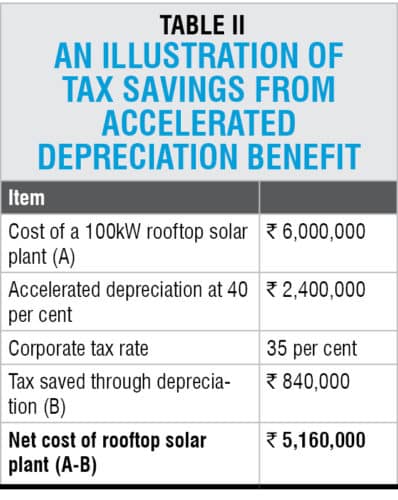
Accelerated depreciation of 80 per cent was available until March 2017 under the Income Tax Act for rooftop solar PV systems, which was halved to 40 per cent from April 1, 2017 onwards. It can provide significant savings to a solar plant developer who is a taxable assesse and has sufficient profits against which the depreciation can be charged. Table II gives an illustration of tax savings from accelerated depreciation benefit.
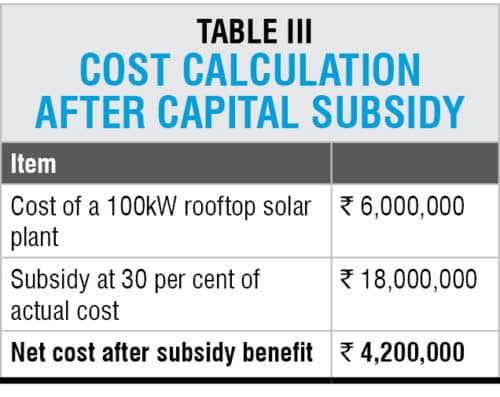
Capital subsidy is provided in many countries for the investment made in rooftop solar power plants. Table II shows calculation for an assumed capital subsidy of 30 per cent.
Investment tax credits has a similar concept as capital subsidies. Here, instead of a direct subsidy on the capital cost, the income tax is deducted by the amount of incentive. The subsidy calculation is illustrated in Table III for an assumed income tax of 30 per cent.
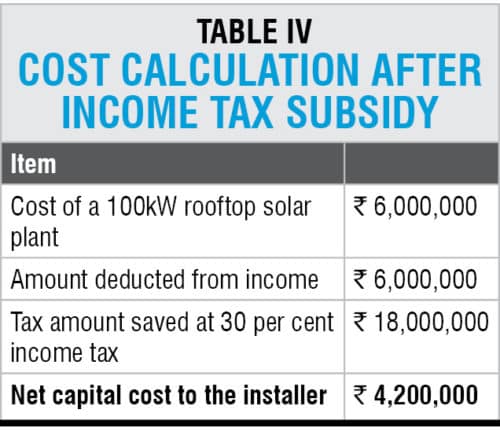
Table IV shows the final cost of a rooftop PV system factoring in subsidies but without batteries. This is an estimate for commercial properties, hence includes accelerated depreciation. A similar estimation can be done for residential properties by including investment tax credits as the incentive in place of accelerated depreciation.
